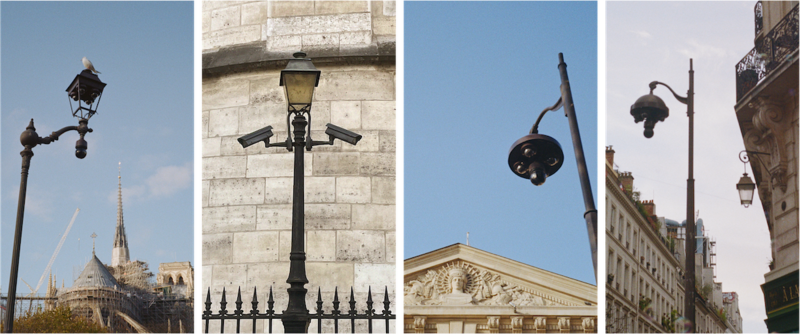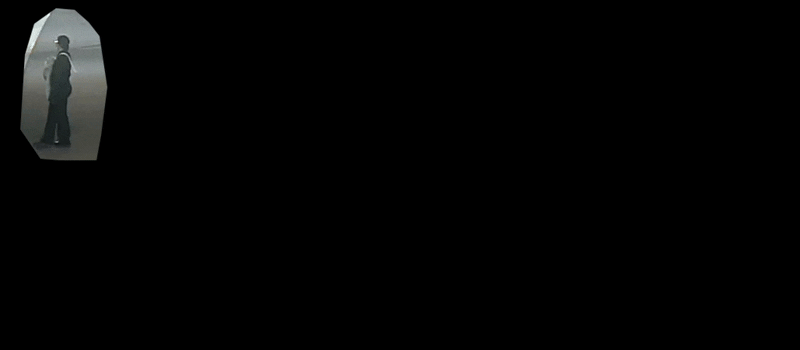Maja Funke - Dead Glitch
»Dead Glitch« is a research project and a multimedia body of work that was initiated in view of the global event of the 2024 Olympic and Paralympic Games in Paris. The project places the issue of comprehensive algorithmic video surveillance at the center of attention.
Urban design is updated in the Parisian gaze. What seems to be a streetlamp is no longer a distributor for romantic light, but a surveillance instance in empire green or anthracite. Some five-eyed sentries are special in their materialization of control and freedom may not seem dissuasive but rather belonging (Fig. 1). This is a security enforcement with symbolic aesthetic, in the heritage of the penetrability of the urban space in Louis’ XIV »Ville Lumière«[1]. This light is more often than not interested in non-white bodies and other visible minorities.

In preparation for the 2024 Olympics, the French government passed a law on March 19, 2023 that includes provisions to improve security, situational (crime) prevention and counterterrorist measures (Article 9 to 19).[2] Among them is the »experimental [sic!]« use of algorithmic video surveillance to control crowds at sporting, leisure and cultural events. The trial will run until the end of March 2025.
Algorithmic Video Surveillance (AVS) consists of the installation and use of software that executes the analysis of videos to detect, identify or classify certain behaviors, situations, objects and people. The various machine-learning-based applications[3] are mainly used by the police in conjunction with surveillance cameras: either for real-time detection of certain suspicious or risky »events« or retrospectively as part of police investigations. Biometric identification allows a person to be recognized in a sample of people on the basis of physical, physiological or behavioral patterns.[4]
While walking Paris in dérive[5], one might sense the onset of normalization of the New Military Urbanism[6]. Counter observation reveals the banalization of a watching city. In the multimedia body of work »Dead Glitch« this walk becomes an investigative performance. In playing with the current legal situation in Paris, the proclaimed zones of AVS are becoming a stage, with the security apparatus documenting the everyday risk-management of the performer and becoming acutely conscious of the resulting instruments of recognition[7] (Fig. 2). The performers journey of becoming data and losing its anonymity and privacy is highlighting these same values a vital for freedom like demonstration, movement and expression.

And yet, as states adopt surveillance and control systems designed for warfare[6] – driven by security concerns, economic interests, and political goals – privacy violations become the norm. These measures, initially temporary, often become permanent after the state of emergency, treating all citizens as suspects and placing AVS in fundamental conflict with democratic values. The title »Dead Glitch« alludes not least to the deadly potential for error entailed by trust in these technologies. »Warfare, like everything else, is being urbanized«[6] and the boomerang of dataveillance is returning to state borders and war zones.[8] Extreme versions of this logic are visible in the automated systems employed in border control (the European security regime)[9] , AI supported military systems (such as in Gaza)[10], as well as in various other developments including Russian and Chinese where the digitalization of warfare is transforming the role of citizens under the Geneva Conventions.[11]
When video surveillance is not a material apparatus, but a practice[1], there is place to argue for a proximity to social justice[12] and bringing back in mind that historically, antifascist countermovements strenghen in response to a tightening of state security.
»By adding cameras, the idea of the romantic city, the city of the flâneur, has shifted. Contemporary city management seems to have different expectations of what public space is and does. Your artistic strategy to claim CCTV data by using GDPR regulations is a wonderful strategy of resistance. This is a laborious endeavour, both for you and the city, that slows down the cogs of the surveillance machine. It functions as a strong example of what "surveillance as a practice" entails, and how CCTV is so much more than mere technology, but a site of contestation.« – as commented by Ruben van de Ven
»2024 Parisian city surveillance is very effective for me, particularly how you aim to understand what "dataveillance" does in crafting, and controlling, citizens' behavior. Thinking alongside Shannon Mattern (particularly her book The City Is Not a Computer), I'd argue that autonomous systems of surveillance might have changed their distribution of materials, but these systems have been equally present in urban design before the CCTV era.« – as commented by Kola Heyward-Rotimi
- ↑ 1.0 1.1 Kammerer, Dietmar: Bilder der Überwachung. Suhrkamp Verlag, 2008.
- ↑ République Française: LOI n° 2023-380 du 19 mai 2023 relative aux jeux Olympiques et Paralympiques de 2024 et portant diverses autres dispositions.
- ↑ Such as Cityvision by Wintics and Briefcam software.
- ↑ https://www.laquadrature.net/vsa/
- ↑ https://situationist.org/periodical/si/issue-2-1958-en/theory-of-the-derive-73
- ↑ 6.0 6.1 6.2 Graham, Stephen: Cities Under Siege: The New Military Urbanism. Verso, 2010.
- ↑ Boehm, Gottfried: Zwischen Auge und Hand : Bilder als Instrumente der Erkenntnis. In: Mit dem Auge denken : Strategien der Sichtbarmachung in wissenschaftlichen und virtuellen Welten. Zürich, 2001, pp. 43-54.
- ↑ Foucault, Michel: Society Must be Defended: Lectures at the Collège de France 1975-76, Penguin Classics 2020.
- ↑ "Wie die EU mit Künstlicher Intelligenz ihre Grenzen schützen will", Algorithm Watch, ZDF Magazine Royale 24 May, 2025. https://fuckoffai.eu/Accessed November 11, 2024.
- ↑ "Targeted? Killing", Forum InformatikerInnen für Frieden, 29 April, 2024. https://blog.fiff.de/content/files/2024/04/2024_04_29_Stellungnahme-lavender.pdf. Accessed 3 May, 2024 and "‘Lavender’: The AI machine directing Israel’s bombing spree in Gaza", +972 Magazine, 3 April, 2024. https://www.972mag.com/lavender-ai-israeli-army-gaza/ Accessed April 15, 2024.
- ↑ Mulligan, Cathy: Automated Warfare and the Geneva Convention. Netzpolitik, 17 April, 2024. https://netzpolitik.org/2024/artificial-intelligence-automated-warfare-and-the-geneva-convention/?via=nl Accessed 11 November, 2024.
- ↑ "Intelligence artificielle : la France ouvre la voie à la surveillance de masse en Europe", Disclose, 22 January, 2025 https://disclose.ngo/fr/article/intelligence-artificielle-la-france-ouvre-la-voie-a-la-surveillance-de-masse-en-europe. Accessed 22 January, 2025.